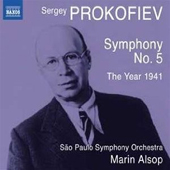

This is conductor Marin Alsop's first recording with the Sao Paulo Symphony Orchestra, an excellent Brazilian ensemble to which
she has just been posted as principal conductor. Although still considered relative neophytes to the recording industry, this orchestra's small handful of previous recordings
on the BIS label, all come highly recommended. This new Alsop/Sao Paulo outing, is the first in a projected complete Prokofiev symphony cycle which promises to be
something well worth anticipating.
It takes but only 25 seconds for the main theme of Sergei Prokofiev's Symphony No. 5 in B flat major, Op. 100,
to establish its stature as one of the best symphonic works of the 20th century. A musical phrase, or statement, that even in its quiet introduction,
holds so much weight and substance. Add to it Prokofiev's masterful grip on its development, and this work's first movement alone is a masterpiece of the genre. Marin
Alsop establishes a measured and ponderous tempo that serves the music very well. The way she handles and shapes slight tempo shifts at critical moments, at the 3:47
mark for example, is to be noted. Each and every member of the orchestra does a fantastic job at pushing their part to the top layer when it's called for, whilst remaining
a key factor within the big picture. Written in 1944, at a time when the Russians were not only suffering major losses due to the war, but were also feeling the oppressive
watchful scrutiny of the Stalin regime, you can actually hear some loud and terrifying poundings on the door, just as the first movement reaches the 7:43 and 7:49 mark.
The whole movement is a perfectly judged build-up of forces that rise to epic proportions, and the Sao Paulo Symphony Orchestra takes second billing to no one during
its few final monumental moments.
The second movement's quick-witted buffoonery aspects are well projected here under Alsop's sprightly tempo, and the whole thing sounds convincingly like a huge parody of the war machine.
A touching Adagio movement follows in which the string sections of this orchestra get a chance to display their full colors, be they dark or bright, and that compared to the previous
movement's pointed wit, they can muster up dramatic effects just as well. The way in which the string players reiterate the symphony's opening motif at the start of the final movement is exemplary,
and the generally upbeat mood (allegro giocoso) of this movement is well conveyed by Alsop's light touch and forward momentum, and all the mischief and
shenanigans that make up the final two minutes of this symphony are played to the hilt by every musician of the orchestra.
The Year 1941, Op. 90, the rarely recorded symphonic suite also from the war years, provides a good, if somewhat lightweight, filler for this CD.
More bombast than substance in the first movement, and repetitive material in the last, it nonetheless has a charming middle slow movement. Placed first on the disc, it acts as a good
appetizer for the much more substantial symphony.
If you prefer to dive right in and acquire all of Prokofiev's symphonies in one tidy package, and an excellent one at that, I would recommend you consider the great set
reviewed here.
If on the other hand you simply want to add a very good budget priced No. 5 to your collection, this new Naxos recording shouldn't be missed.
Jean-Yves Duperron - July 2012